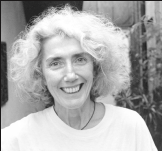By Stephanie Murg
A little over a decade ago, the young daughter of painter Elizabeth Murray walked into her mother’s soon-to-open show at the Paula Cooper Gallery, looked around, and burst into tears. “What are these paintings doing here? You’re not going to sell these paintings!?” sobbed four-year-old Sophia to her mother. “Don’t give these paintings to Paula. These paintings are ours.” Anyone who has seen the work of Murray, much less enjoyed the privilege of living with it, can understand Sophia’s reaction.
Murray, a Tribeca resident who died from lung cancer complications on August 12 at the age of 66, devised an original, ever-evolving style of painting that evades neat classification into an “-ism” and defies both comparison and easy description. Her vividly-colored, eccentrically-shaped compositions capture moments of spirited conversations among cartoony forms and bold, bendy caricatures of quotidian objects such as shoes, teacups, spoons, and tables.
Murray’s success at synthesizing such diverse influences as Rockwell, Disney, Cezanne, DeKooning, Oldenburg, and Johns makes it impossible to isolate an element of her own work as a decisive nod to another, which has both thwarted and invigorated critics. In a 2005 Artforum essay, artist Carroll Dunham described the result of Murray’s literally multi-layered works, which often included multiple stretchers in various contortions, as “a kind of trippy distortion, like having an odd new thought about something you’ve seen innumerable times before.” She went on to highlight the air of pluripotence that pervades Murray’s paintings. “One feels before her work that it is both stable and provisional, as though the paintings were composed of some exotic plasma that could still resume its morphic flow.”
Taking in last year’s retrospective of her 40-year-career at the Museum of Modern Art, one was convinced of the depth of Murray’s work, even if it remained winkingly elusive to explain. When asked recently about the interplay of abstract and recognizable forms in her paintings, Murray made clear the scope of her ambitions. “I want both. I want all things. I want everything,” she said. “I want to be able to say, ‘Oh, that’s a cloud with windows, or that’s just this floating weird bloopy shape with cut outs.’ Because I enjoy that. I enjoy the possibilities of all of these forms.”
Born in Chicago in 1940, Murray entered the Art Institute of Chicago in 1958 with the idea that she would study advertising and be an illustrator. After a year of walking through the museum galleries to get to class, she changed her mind and focused on painting, ultimately earning an M.F.A. from Mills College in California. She moved to New York City with her first husband in 1967, around the time when critic Clement Greenberg was diagnosing painting with a crippling virus of superficial variety and prescribing the cure-all of Minimalism.
Within nine years, Murray had given birth to a son, scrapped acrylic for oils, got a divorce, and had her first solo show at Paula Cooper. In the years that followed, she experimented with shaped canvases, more recognizable (and biomorphic) forms, and a bolder, more saturated palette. She also remarried, to poet Robert Holman, and had two daughters. Along the way, she helped to revive painting and seemed to have a lot of fun in the process.
Like her paintings, Murray possessed a percolating energy that fueled a purposeful, innovative engine of whimsy. “My fantasy was that I would get to a certain point and I would know what I wanted to say,” Murray once told an interviewer. “You were on this straight and narrow road and you would never swerve and you would just do your work then. And that’s not the way it is, at all. You get off the path and then get back on again for awhile, and you trip along and then suddenly you stumble and you’re back on again. I don’t think that process ever ends.”



























